Getting a text message from short code 97539 can question its purpose and validity, especially at a time when digital communication is widespread with both opportunities and risks. As a registered short code, 97539 is used by companies for information, verification or marketing, but requires careful investigation into demand for various applications and ability to abuse. In 2025, with increasing dependence on SMS for safe communication, it is important to understand the original, use and precautions related to 97539 text messages. This article can safely navigate 97539 texts, their sources and users, and examine the nature of nature adapted to those seeking clarity on the subject.
What Is a 97539 Text Message?
A text message of 97539 comes from a short code of five digits, which is a special number used by companies to send SMS or MMS messages on mobile phones. Small codes such as 97539 are designed for high power, automatic messages, often for verification of accounts, marketing campaigns or notice, for shortcode.org. Unlike traditional telephone numbers, they allow fast delivery to larger target groups, making them ideal for time -sensitive communication. However, the sender’s identity may not always be clear, motivating users to check the purpose and validity of the message before responding, especially given the increase in SMS-based fraud.
Common Sources of 97539 Texts
The 97539 short code is associated with various legitimate services, though the exact sender can vary based on the user’s interactions. For instance, texting “HELP” to 97539 may return a response indicating a connection to Steve Madden, a retail brand, with support at support@attentivemobile.com, per shortcodes.info. Other sources include third-party services using T-Mobile’s network for verification codes, account alerts, or promotional offers, as noted by pixelsseo.com. Additionally, the short code is registered to AMSociety6 for messaging campaigns, per textingworld.com. These diverse applications highlight the need to verify the sender based on recent activities, such as online registrations or subscriptions.
Legitimate Uses of 97539
Valid 97539 Text messages often serve targets such as two-factor authentication (2FA), account information or marketing propaganda. For example, banks or social media platforms can use short code to send login verification code or password reset, ensure secure access, per pixel dot com. Store suppliers such as Steve Maden or Amasociate6 sent proposals to enroll in customers, such as discounts or events invited. These messages are usually sent to the user’s consent and correspond to FCC rules on SMS marketing. Users can confirm the validity by checking identifiable brand names or relevant account activity, and ensuring that the message matches the interaction.
Risks of Spam and Scams
Despite legitimate uses, 97539 texts can be exploited by scammers, as reported by RoboKiller users who flagged spam from this number, per lookup.robokiller.com. Common scams include phishing attempts with suspicious links or requests for personal information like credit card details, per verified.org. For instance, unsolicited messages claiming urgent account issues may trick users into clicking malicious URLs. With smishing (SMS phishing) attacks rising by 58% in 2024, per AT&T’s Cyber Aware, users must exercise caution, avoiding unknown links and never sharing sensitive data via text, to mitigate risks associated with 97539 messages.
How to Verify a 97539 Text Message
The 97539 verification of the text message involves checking the reference and source. If the message refers to a recent action, such as login efforts or purchases, it is potentially valid, Per Sihasah.com. The “Help” cover for 97539 can provide sender details, such as contact information or cancellation instructions. Cross-referral with official brand communication, such as Steve Maden’s email, adds security. Online lookup tools, such as shortcods. Inpho, provide insight into registered users of short code. If the message does not work related to your activities, block the number and report it to your carrier to prevent possible fraud.
Managing Unwanted 97539 Texts
To stop unwanted 97539 texts, users can text “STOP” to the short code, which typically unsubscribes them from marketing messages, per textingworld.com. This action is effective for legitimate senders like AMSociety6 but may incur charges with some short codes, so checking carrier policies is wise, per shortcodes.info. Blocking the number via smartphone settings prevents further messages, while reporting spam to services like RoboKiller or the FTC enhances community safety. For persistent issues, contacting the sender’s support, such as support@attentivemobile.com for Steve Madden, can resolve subscription errors, ensuring a spam-free inbox.
Privacy and Security Considerations
Privacy is a key concern with 97539 texts, as short codes collect data like phone numbers and interaction histories, per sihasah.com. Legitimate senders adhere to TCPA guidelines, requiring user consent, but scammers may bypass these, risking data exposure. Users should avoid sharing personal details and use two-factor authentication for sensitive accounts to enhance security. Emerging tools, like carrier-based spam filters, block 30% more fraudulent texts in 2025, per AT&T Newsroom. Regularly reviewing subscription lists and opting out of unnecessary services further protects privacy when receiving 97539 messages.
The Role of Short Codes in 2025
Small codes such as 97539 are important in 2025, 80% of business with businessmen who use SMS for engagement, Per EzTexting.com. Their efficiency in goals, time -sensitive messages make them ideal for industries such as retail, finance and health care. However, the site emphasizes the need for consumer education and strong carrier. AI-operated spam detection and blockchain-based sender verification increase the credibility of innovation card code, leading to 97539 and similar codes are reliable communication channels. Understanding their role helps users distinguish between valid and scams, which promote safe digital interactions.
Future Trends in SMS Communication
Looking ahead, the use of short codes like 97539 will evolve with advancements in AI and regulatory frameworks. AI-powered analytics will improve message personalization, increasing engagement by 25%, per tatango.com. Regulatory changes, such as stricter TCPA enforcement, will mandate clearer opt-in processes, reducing spam risks. Integration with RCS (Rich Communication Services) will enhance short code capabilities, offering interactive features like buttons or images, per sihasah.com. These trends ensure 97539 texts remain relevant, balancing efficiency with security in an increasingly connected world.
Conclusion
A versatile short code used by brands such as 97539 Text messages, Steve Maden and Aimsoc 6 provide an example of the power and complexity of SMS communication in 2025. While serving valid goals such as verification and promotion also lead to the risk of spam and fraud, which requires vigilance. By verifying sources, managing membership and prioritizing privacy, users can safely navigate in 97539 texts. As card coding technology develops with AI and regulatory progress, its role in safe, effective communication will increase. Understanding and managing 97539 messages gives users the right to take advantage of their benefits while preserving in a dynamic digital scenario.

